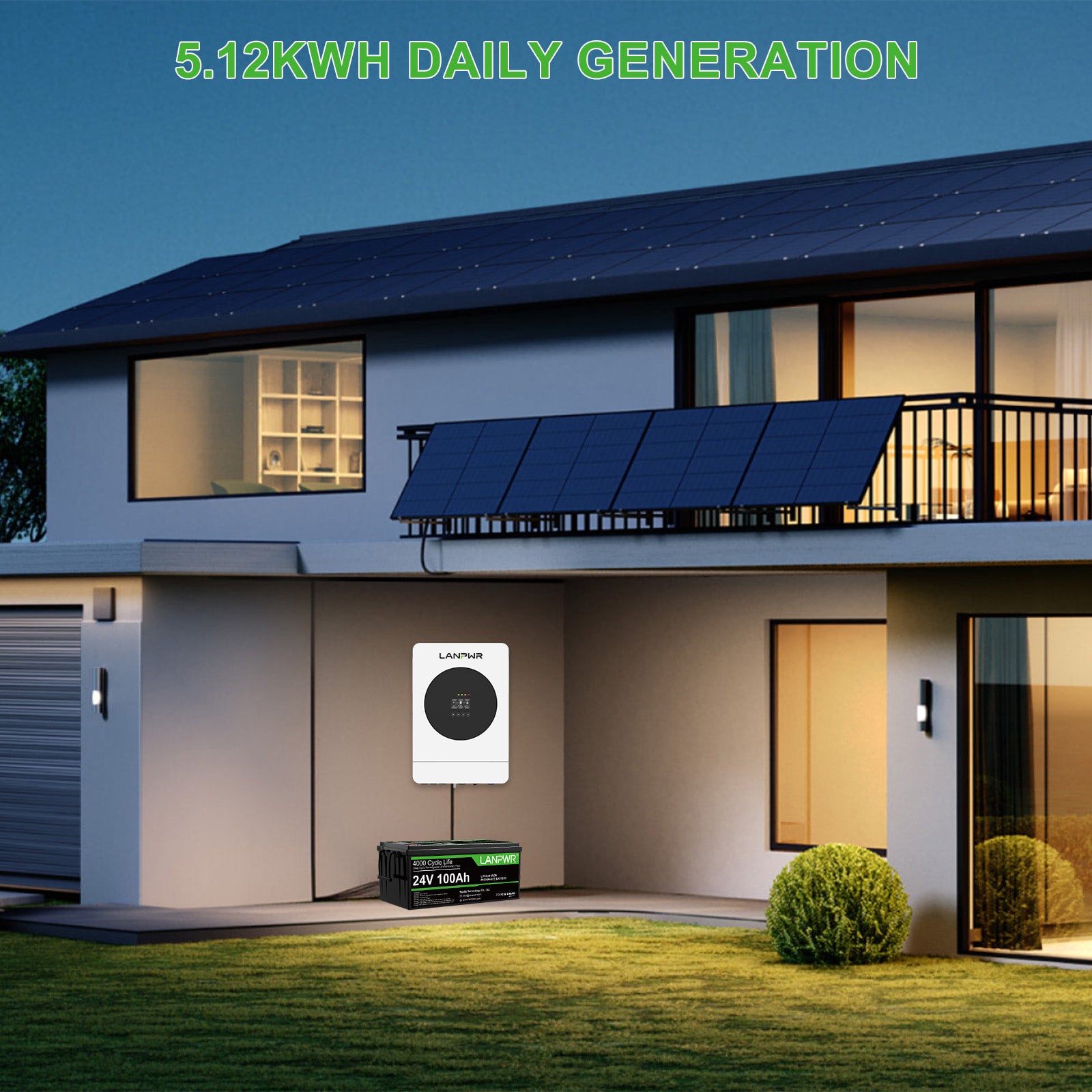Introduction
The shift towards sustainable and reliable energy solutions has significantly elevated the status of LiFePO4 batteries in off-grid applications. Known for their robust performance and superior safety features, these batteries quickly become the go-to choice for those seeking dependable power sources without the grid. Their rising popularity is underscored by their numerous advantages over traditional lithium-ion batteries, offering a blend of durability, safety, and environmental benefits that align well with contemporary energy needs.
The enhanced safety features, a longer lifespan, and stability under various operating conditions make LiFePO4 batteries particularly suitable for off-grid energy systems. This blog delves into the reasons behind their increasing use and discusses the key benefits that make them preferable over traditional battery technologies. We will explore the technological specifics, applications, cost considerations, performance metrics, and the sustainable future of LiFePO4 battery technology.
Understanding LiFePO4 Battery Technology
What is a LiFePO4 Battery?
Composition and Chemical Properties
LiFePO4 batteries, characterized by their lithium iron phosphate chemistry, provide stable and safe battery technology. The key to their stability lies in the phosphate-based cathode material, which is inherently safer than the cobalt oxide used in traditional lithium-ion batteries. This fundamental difference in material composition reduces the risk of thermal runaway. It prevents the battery from catching fire or exploding under normal usage circumstances, offering an added layer of safety.
Beyond safety, the chemical composition of LiFePO4 batteries contributes to their long service life and stable performance. The iron phosphate chemistry facilitates a strong bond in the battery's structure, which resists breakdown even under challenging conditions. This robustness allows the battery to maintain consistent performance over time, enhancing its suitability for long-term applications such as renewable energy storage.
Key Technological Features
LiFePO4 batteries boast a series of technological features that make them a superior choice for energy storage. One of the most significant advantages is their ability to maintain voltage levels throughout the discharge cycle, which is crucial for devices that require a steady power supply. Additionally, these batteries can endure thousands of charging and discharging cycles with minimal capacity loss, making them an ideal solution for systems that require frequent cycling, like solar energy storage.
The structural integrity of LiFePO4 batteries further contributes to their reliability. Unlike other battery types, they do not swell, leak, or degrade quickly under normal operating conditions, ensuring longevity and consistent performance. This resilience makes them particularly attractive for critical applications where reliability is paramount.
Comparison with Other Battery Types
LiFePO4 vs Lithium-Ion
The comparison between LiFePO4 and traditional lithium-ion batteries highlights significant differences in safety and longevity. Conventional lithium-ion batteries, while efficient, if damaged or improperly handled. In contrast, LiFePO4 batteries offer a much safer alternative due to their stable chemical structure and lower risk of thermal events.
Furthermore, LiFePO4 batteries have a longer operational lifespan than lithium-ion variants. This is due to their ability to handle more charge-discharge cycles before experiencing significant degradation. Such durability makes them more cost-effective and lessens the environmental impact due to reduced waste.
Benefits Over Other Technologies
Besides safety and durability, LiFePO4 batteries also stand out for their environmental benefits. They are made from non-toxic materials, making them less harmful to produce and recycle than batteries containing heavy metals like cobalt. This aspect is particularly appealing in a world that is increasingly conscious of its ecological footprint.
Moreover, the efficiency of LiFePO4 batteries' energy density and discharge rates makes them highly effective for various applications. Their ability to quickly release and store energy efficiently makes them suitable for high-load applications, a necessity in many off-grid and backup power scenarios. This combination of environmental and operational advantages establishes LiFePO4 batteries as a forward-looking technology in the energy sector.

LiFePO4 Battery Applications and Installations
Common Applications
Residential (Homes)
LiFePO4 batteries are becoming increasingly common in residential settings, particularly in homes with solar panels or remote areas where grid reliability is an issue. These batteries provide a dependable power source capable of storing solar energy throughout the day and seamlessly supplying it during grid availability fluctuations or at night.
In addition to their functional benefits, LiFePO4 batteries in residential applications contribute to energy independence. By enabling homeowners to store and manage their energy, these batteries minimize reliance on external power sources, which can be unpredictable and costly. This autonomy is precious in regions where power outages are common or in rural areas where grid connections may be weak or non-existent.
Mobile Applications (RVs and Boats)
LiFePO4 batteries offer an ideal power solution for those who live a mobile lifestyle, whether in RVs or boats. These batteries provide a reliable and robust energy source that can handle the dynamic conditions of mobile living. From powering appliances to ensuring that navigation and communication systems are operational, LiFePO4 batteries enhance the comfort and safety of mobile dwellings.
LiFePO4 batteries' durability is a significant advantage in mobile applications with typical vibration and temperature fluctuations. The ability to operate effectively in a wide range of environmental conditions without degrading quickly makes them suitable for use in RVs and boats, where other types of batteries might fail. Furthermore, their lightweight nature contributes to better fuel efficiency, which is crucial in mobile applications where weight is a constant consideration.
Installation Guidelines
Installation Best Practices
Correct installation is crucial for maximizing the performance and lifespan of LiFePO4 batteries. It involves several best practices, such as ensuring proper ventilation to avoid overheating and arranging the batteries in a stable, secure manner to prevent physical damage. Additionally, using compatible components such as charge controllers and inverters that match the electrical characteristics of LiFePO4 batteries is essential for maintaining system efficiency and safety.
When installing LiFePO4 batteries, it is also essential to consider the orientation and positioning within the space available. These versatile batteries can be installed in various orientations, easily fitting into different configurations. Proper installation not only ensures optimal performance but also enhances the overall safety of the energy storage system, preventing issues related to improper electrical connections or environmental exposure.
Safety Considerations
Safety is paramount when dealing with any high-capacity battery system, and LiFePO4 batteries are no exception. Despite their inherent safety advantages, they must be handled with care and respect to the manufacturer's guidelines.
In addition to following charging guidelines, installing protective mechanisms such as circuit breakers and fuses is crucial. These devices provide an essential safety layer by preventing electrical overloads and protecting the battery and the connected devices.
Cost and Accessibility of LiFePO4 Batteries
Analyzing the Cost
Initial Investment
The initial cost of LiFePO4 batteries is generally higher than that of traditional lead-acid or standard lithium-ion batteries. This is due to their production of advanced materials and technology, which contributes to their superior performance and safety characteristics. However, when considering the total cost of ownership,.
Investing in LiFePO4 technology makes economic sense for those who require reliable and long-lasting energy storage solutions. Although the upfront cost may be significant, the return on investment becomes apparent through reduced energy costs, fewer battery replacements, and less downtime due to battery failures. This makes LiFePO4 batteries an attractive option for residential and commercial users seeking to maximize their energy efficiency and cost-effectiveness.
Long-Term Savings
The long-term financial benefits of LiFePO4 batteries are compelling. Their ability to withstand thousands of charge and discharge cycles without significant degradation reduces the need for frequent replacements, translating into substantial savings over time. Additionally, their high efficiency in both charging and discharging minimizes energy loss, further lowering operational costs.
For off-grid systems, particularly those that rely on solar power, LiFePO4 batteries enhance the return on investment by maximizing the use of solar energy generated. This efficiency reduces reliance on diesel generators or grid electricity and decreases ongoing energy expenses. As a result, the initial higher investment in LiFePO4 technology can be offset by long-term savings and increased energy autonomy.

Finding Affordable Options
Choosing the Best LiFePO4 Battery
Selecting the best LiFePO4 battery requires careful consideration of several factors, including the specific energy needs, the intended application, and the existing energy system configuration. The battery's capacity, discharge rate, and charge cycle lifespan must be evaluated to meet the application's demands. Choosing a battery from a reputable manufacturer like LANPWR can also guarantee higher quality and reliability.
This can provide insights into the batteries' real-world performance and reliability. Furthermore, consulting with energy storage experts or vendors can offer professional guidance tailored to specific needs, ensuring that the chosen battery best fits the intended purpose.
Top Suppliers in Europe
Europe is home to LiFePO4 battery suppliers, who offer products suitable for various residential, commercial, and industrial applications. These suppliers are known for their commitment to quality and innovation, frequently incorporating the latest advancements in battery technology into their offerings.
When considering suppliers, looking at their product range, customer service, and post-sale support is essential. Suppliers who provide detailed product information, transparent pricing, and reliable customer support should be prioritized. Additionally, considering suppliers who engage in sustainable practices can also be beneficial, aligning with the overall environmental benefits of LiFePO4 technology.
Performance and Lifespan in Off-Grid Settings
Battery Lifespan
Factors Influencing Lifespan
Several factors influence the lifespan of a LiFePO4 battery and can either extend or reduce its practical service life. Key among these is the depth of discharge (DoD), the frequency of charging and discharging, and the operating temperature. Batteries cycled deeply (i.e., used until a significant portion of their capacity is depleted before recharging) regularly tend to have shorter lifespans due to increased wear and tear on the chemical components.
Another critical factor is the battery management system's (BMS) quality. Properly managing these factors through careful use and adequate system design can dramatically extend the operational life of LiFePO4 batteries, making them a cost-effective solution for long-term applications.
Average Lifespan in Off-Grid Use
In off-grid applications, LiFePO4 batteries typically boast an impressive lifespan, providing between 5,000 and 7,000 cycles at 80% depth of discharge. Depending on the frequency of cycles and the conditions of use, this can translate to well over a decade of reliable service. The longevity of these batteries is particularly advantageous in off-grid settings, where reliability and the ability to sustain continuous power are paramount.
LiFePO4 batteries' durability under various environmental conditions also contributes to their longevity. They are less sensitive to temperature variations than other types of batteries and maintain a high level of performance even under harsh or fluctuating conditions. This resilience suits them for off-grid systems in remote or challenging environments where maintenance and replacement can be difficult and costly.
Performance Metrics
Capacity and Efficiency
LiFePO4 batteries are highly regarded for their capacity retention and overall efficiency. They can maintain a high capacity even after many charge cycles, ensuring a consistent energy supply. Their high efficiency in both charge and discharge processes minimizes energy loss, which is crucial for systems where every watt of power is valuable.
These batteries also exhibit excellent rate capabilities, which can handle high charge and discharge rates without significant performance degradation. This is particularly beneficial in off-grid applications where sudden loads or high power demands can occur frequently, as it ensures the battery can meet these demands without faltering.
Impact of Environmental Factors
However, LiFePO4 batteries are designed to be robust against such factors. They perform well in various temperatures and are less likely to degrade in hot or cold conditions than other battery types.
Moreover, the solid structure of LiFePO4 batteries provides an additional layer of protection against physical stress, making them less susceptible to damage from shock or vibration. This is especially important in off-grid applications where the battery may be subjected to varied and potentially harsh conditions. The inherent robustness of LiFePO4 batteries ensures that they continue to perform optimally, even in less-than-ideal environmental situations.
Charging and Maintenance of LiFePO4 Batteries
Charging Practices
Optimal Charging Strategies
Using a charger specifically designed for LiFePO4 chemistry is essential, ensuring the battery is charged within its safe voltage range. Overcharging or undercharging can significantly reduce the battery's lifespan and performance, so maintaining the correct charge levels is paramount.
Additionally, the rate at which the battery is charged can impact its health and longevity. Fast charging can be convenient, potentially shortening their lifespan. A charging strategy that balances speed and battery health is vital, especially in off-grid applications where battery reliability is critical.
Solar Power Integration
These batteries are particularly well-suited for solar applications due to their high charge efficiency and the ability to handle intermittent charging conditions. They are familiar with solar energy due to variable sunlight exposure.
The compatibility of LiFePO4 batteries with renewable energy sources like solar power enhances energy independence and contributes to environmental sustainability. Properly configuring the solar panels and battery storage system ensures that the maximum amount of solar energy is captured and stored, reducing reliance on non-renewable power sources and minimizing carbon emissions.
Routine Maintenance
Regular Checks and Balancing
Regular maintenance is necessary to maximize the performance and extend the lifespan of LiFePO4 batteries. Periodic checks should include:
- Monitoring the battery's state of charge.
- Checking for signs of wear or damage.
- Ensuring that connections are clean and secure.
Additionally, balancing the cells within the battery periodically ensures that each cell contributes equally to the battery's performance, preventing premature wear.
A routine maintenance schedule helps identify potential issues before they become serious problems. This proactive approach maintains the battery's efficiency and prevents downtime, which can be crucial in off-grid applications where consistent power availability is necessary.
Preventative Maintenance Tips
Preventative maintenance practices, such as ensuring the battery is operated within its recommended temperature range and avoiding exposure to moisture, can significantly enhance its durability. Keeping the battery area clean and debris-free also helps prevent accidental shorts and promotes better air circulation, improving battery performance and lifespan.
Using battery management systems (BMS) can also aid in preventative maintenance by automatically monitoring and adjusting the battery's conditions to prevent overcharging, deep discharging, and other harmful practices. A well-configured BMS not only simplifies maintenance tasks.
Sustainability and Future Outlook
Recycling and Environmental Impact
Recycling Processes
LiFePO4 batteries are straightforward to recycle due to their non-toxic and stable chemical composition. The absence of heavy metals and other hazardous materials makes these batteries less harmful to the environment and more accessible to recycle than other types of batteries.

Implementing effective recycling programs is essential for maximizing the environmental benefits of LiFePO4 batteries. By ensuring that used batteries are correctly handled and recycled, we can minimize their environmental impact and promote a circular economy in which battery materials are reused rather than discarded.
Sustainability Benefits
The use of LiFePO4 batteries contributes significantly to environmental sustainability. Their long lifespan and high efficiency reduce the need for frequent replacements and energy wastage. Moreover, their compatibility with renewable energy sources like solar power enhances their sustainability profile.
The environmental benefits of LiFePO4 batteries extend beyond their operational lifecycle. Their potential for recycling and their consequences for reducing greenhouse gas emissions position them as an environmentally responsible choice for energy storage.
Advancements in LiFePO4 Technology
Future Innovations
The field of LiFePO4 battery technology is continuously evolving, with research focused on enhancing their energy density and reducing costs. Future advancements may include developing new electrode materials or improvements in battery design that increase these batteries' storage capacity and efficiency. Such innovations are expected to make LiFePO4 batteries even for a broader range of applications, including electric vehicles and large-scale energy storage systems.
Investments in research and development are crucial for pushing the boundaries of what is possible with LiFePO4 technology. By supporting innovation in this area, manufacturers and researchers can accelerate the adoption of these batteries in global markets, making them more accessible and affordable for consumers worldwide.
Market Trends and Predictions
The market for LiFePO4 batteries is set to expand significantly in the coming years, driven by the increasing demand for safe, reliable, and sustainable energy storage solutions. The growing interest in renewable energy and the shift towards electrification contribute to this trend. As consumers and businesses recognize the importance of LiFePO4 batteries, their market share is expected to grow in established sectors such as renewable energy storage and emerging markets such as electric transportation.
Anticipating and responding to market trends is essential for stakeholders in the LiFePO4 industry. Manufacturers need to continue improving their products and reducing costs to stay competitive. Additionally, policymakers and regulators can facilitate the adoption of advanced battery technologies by creating favorable regulatory environments and supporting incentives for clean energy technologies.
Conclusion
LiFePO4 batteries represent a significant advancement in energy storage. They offer a combination of performance, safety, and environmental benefits that suit them for various uses, especially in off-grid settings. Their robustness, efficiency, and compatibility with renewable energy sources provide a solid foundation for building sustainable and reliable energy systems.
As the technology behind LiFePO4 batteries continues to evolve, their role in global energy solutions is expected to grow, highlighting the importance of adopting these advanced energy storage options. For consumers, businesses, and energy systems designers, LiFePO4 batteries offer a promising path toward achieving greater energy independence and environmental sustainability. Embracing this technology makes sense economically and aligns with broader ecological goals, making it a wise choice for a sustainable future.














Leave a comment
This site is protected by hCaptcha and the hCaptcha Privacy Policy and Terms of Service apply.